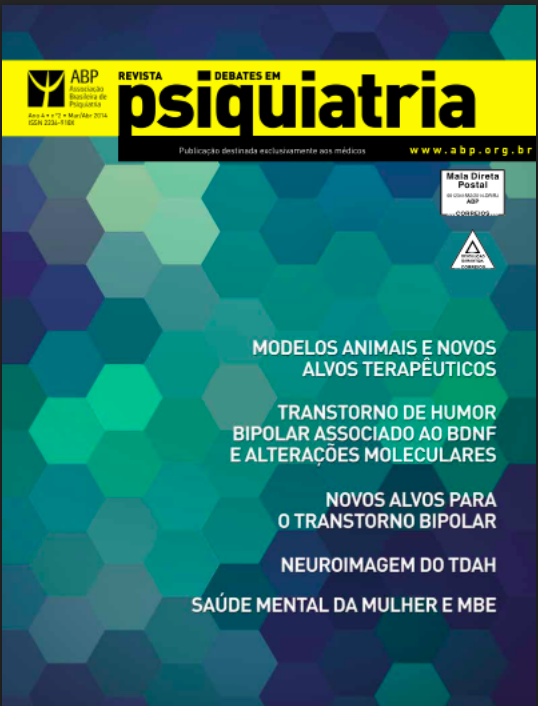ADHD neuroimaging: findings from structural and functional magnetic resonance imaging
DOI:
https://doi.org/10.25118/2763-9037.2014.v4.248Keywords:
ADHD, structural MRI, functional MRI, default mode network, intrinsic functional connectivity, resting state functional connectivityAbstract
This review first describes the operation of the following MRI methodologies: Voxel-based morphometry, surface-based morphometry, diffusion tensor imaging, task-based fMRI and resting state fMRI. Then brings the key findings of these techniques in the study of ADHD.
Downloads
Metrics
References
Matthews M, Nigg JT, Fair DA. Attention Deficit Hyperactivity Disorder. Curr Top Behav Neurosci. 2013;11.Epub ahead of print. https://doi.org/10.1007/978-3-662-45758-0_249 DOI: https://doi.org/10.1007/978-3-662-45758-0_249
Cortese S, Castellanos FX. Neuroimaging of attentiondeficit/hyperactivity disorder: current neuroscience-informed perspectives for clinicians. Curr Psychiatry Rep. 2012;14:568-78. https://doi.org/10.1007/s11920-012-0310-y DOI: https://doi.org/10.1007/s11920-012-0310-y
Valera EM, Faraone SV, Murray KE, Seidman LJ. Meta-analysis of structural imaging findings in attention-deficit/ hyperactivity disorder. Biol Psychiatry. 2007;61:1361-9. https://doi.org/10.1016/j.biopsych.2006.06.011 DOI: https://doi.org/10.1016/j.biopsych.2006.06.011
Ellison-Wright I, Ellison-Wright Z, Bullmore E. Structural brain change in ADHD identified by meta-analysis. BMC Psychiatry. 2008;8:1-8. https://doi.org/10.1186/1471-244X-8-51 DOI: https://doi.org/10.1186/1471-244X-8-51
Nakao T, Radua J, Rubia K, Mataix-Cols D. Gray Matter Volume Abnormalities in ADHD: Voxel-Based Meta-Analysis Exploring the Effects of Age and Stimulant Medication. Am J Psychiatry. 2011;168:1154-63. https://doi.org/10.1176/appi.ajp.2011.11020281 DOI: https://doi.org/10.1176/appi.ajp.2011.11020281
Sowell ER, Thompson PM, Welcome SE, Henkenius AL, Toga AW, Peterson BS. Cortical abnormalities in children and adolescents with attention-deficit hyperactivity disorder. Lancet. 2003;362:1699-707. https://doi.org/10.1016/S0140-6736(03)14842-8 DOI: https://doi.org/10.1016/S0140-6736(03)14842-8
Shaw P, Clasen L, Giedd J, Rapoport J. Longitudinal mapping of cortical thickness and clinical outcome in children and adolescents with attention-eficit/hyperactivity disorder. Arch Gen Psychiatry. 2006;63:540-9. https://doi.org/10.1001/archpsyc.63.5.540 DOI: https://doi.org/10.1001/archpsyc.63.5.540
Wolosin SM, Richardson ME, Hennessey JG, Denckla MB, Mostofsky SH. Abnormal cerebral cortex structure in children with ADHD. Hum Brain Mapp. 2009;30:175-84. https://doi.org/10.1002/hbm.20496 DOI: https://doi.org/10.1002/hbm.20496
Narr KL, Woods RP, Lin J, et al. Widespread cortical thinning is a robust anatomical marker for attention-deficit/ hyperactivity disorder. J Am Acad Child Adolesc Psychiatry. 2009;48:1014-22. https://doi.org/10.1097/CHI.0b013e3181b395c0 DOI: https://doi.org/10.1097/CHI.0b013e3181b395c0
Shaw P, Eckstrand K, Lerch JP, Greenstein D, ClasenL. Attention-deficit/hyperactivity disorder is characterized by a dealy in cortical maturation. PNAS. 2007:1-6.
Shaw P, Gornick M, Lerch J, et al. Polymorphisms of the dopamine D4 receptor, clinical outcome, and cortical structure in attention-deficit/hyperactivity disorder. Arch Gen Psychiatry. 2007;64:921-31. https://doi.org/10.1001/archpsyc.64.8.921 DOI: https://doi.org/10.1001/archpsyc.64.8.921
Ivanov I, Bansal R, Hao X, et al. Morphological abnormalities of the thalamus in youths with attention deficit hyperactivity disorder. Am J Psychiatry. 2010;167:397-408. https://doi.org/10.1176/appi.ajp.2009.09030398 DOI: https://doi.org/10.1176/appi.ajp.2009.09030398
Ashtari M, Kumra S, Bhaskar SL, et al. Attention-deficit/ hyperactivity disorder: a preliminary diffusion tensor imaging study. Biol Psychiatry. 2005;57:448-55. https://doi.org/10.1016/j.biopsych.2004.11.047 DOI: https://doi.org/10.1016/j.biopsych.2004.11.047
Casey BJ, Epstein JN, Buhle J, et al. Frontostriatal connectivity and its role in cognitive control in parent-child dyads with ADHD. Am J Psychiatry. 2007;164:1729-36. https://doi.org/10.1176/appi.ajp.2007.06101754 DOI: https://doi.org/10.1176/appi.ajp.2007.06101754
Hamilton LS, Levitt JG, O'Neill J, et al. Reduced white matter integrity in attention-deficit hyperactivity disorder. Neuroreport. 2008;19:1705-8. https://doi.org/10.1097/WNR.0b013e3283174415 DOI: https://doi.org/10.1097/WNR.0b013e3283174415
Cao Q, Sun L, Gong G, et al. The macrostructural and microstructural abnormalities of corpus callosum in children with attention deficit/hyperactivity disorder: A combined morphometric and diffusion tensor MRI study. Brain Res. 2010;1310:172-180. https://doi.org/10.1016/j.brainres.2009.10.031 DOI: https://doi.org/10.1016/j.brainres.2009.10.031
Kobel M, Bechtel N, Specht K, et al. Structural and functional imaging approaches in attention deficit/hyperactivity disorder: does the temporal lobe play a key role? Psychiatry Res. 2010;183:230-6. https://doi.org/10.1016/j.pscychresns.2010.03.010 DOI: https://doi.org/10.1016/j.pscychresns.2010.03.010
Davenport ND, Karatekin C, White T, Lim KO. Differential fractional anisotropy abnormalities in adolescents with ADHD or schizophrenia. Psychiatry Res. 2010;181:193-8. https://doi.org/10.1016/j.pscychresns.2009.10.012 DOI: https://doi.org/10.1016/j.pscychresns.2009.10.012
Konrad K, Eickhoff SB. Is the ADHD brain wired differently? A review on structural and functional connectivity in attention deficit hyperactivity disorder. Hum Brain Mapp. 2010;31:904-16. https://doi.org/10.1002/hbm.21058 DOI: https://doi.org/10.1002/hbm.21058
Ogawa S, Lee TM, Kay AR, Tank DW. Brain magnetic resonance imaging with contrast dependent on blood oxygenation. Proc Natl Acad Sci USA. 1990;87:9868-72. https://doi.org/10.1073/pnas.87.24.9868 DOI: https://doi.org/10.1073/pnas.87.24.9868
Dickstein SG, Bannon K, Milham MP. The neural correlates of attention deficit hyperactivity disorder: an ALE meta-analysis. J Child Psychol Psychiatry. 2006;47:1051-62. https://doi.org/10.1111/j.1469-7610.2006.01671.x DOI: https://doi.org/10.1111/j.1469-7610.2006.01671.x
Buckner RL, Andrews-Hanna JR, Schacter DL. The brain's default network: anatomy, function, and relevance to disease. Ann N Y Acad Sci. 2008;1124:1-38. https://doi.org/10.1196/annals.1440.011 DOI: https://doi.org/10.1196/annals.1440.011
Sonuga-Barke EJS, Castellanos FX. Spontaneous attentional fluctuations in impaired states and pathologicalconditions: a neurobiological hypothesis. Neurosci Biobehav Rev. 2007;31:977-86. https://doi.org/10.1016/j.neubiorev.2007.02.005 DOI: https://doi.org/10.1016/j.neubiorev.2007.02.005
Lin P, Sun J, Yu G, et al. Global and local brain network reorganization in attention-deficit/hyperactivity disorder. Brain Imaging and Behavior. 2013;11.Epub ahead of print. 25. Fair DA, Posner J, Nagel BJ, et al. Atypical default network connectivity in youth with attention-deficit/hyperactivity disorder. Biol Psychiatry. 2010;68:1084-91. https://doi.org/10.1016/j.biopsych.2010.07.003 DOI: https://doi.org/10.1016/j.biopsych.2010.07.003
Castellanos FX, Margulies DS, Kelly C, et al. Cingulate-precuneus interactions: a new locus of dysfunction in adult attention-deficit/hyperactivity disorder. Biol Psychiatry. 2008;63:332-7. https://doi.org/10.1016/j.biopsych.2007.06.025 DOI: https://doi.org/10.1016/j.biopsych.2007.06.025
Rubia K, Halari R, Mohammad A-M, Taylor E, Brammer M. Methylphenidate normalizes frontocingulate underactivation during error processing in attention-deficit/hyperactivity disorder. Biol Psychiatry. 2011;70:255-62. https://doi.org/10.1016/j.biopsych.2011.04.018 DOI: https://doi.org/10.1016/j.biopsych.2011.04.018
Nooner KB, Colcombe SJ, Tobe RH, et al. The NKIRockland Sample: A Model for Accelerating the Pace of Discovery Science in Psychiatry. Front Neurosci. 2012;6:152. https://doi.org/10.3389/fnins.2012.00152 DOI: https://doi.org/10.3389/fnins.2012.00152
Downloads
Published
How to Cite
Conference Proceedings Volume
Section
License
Copyright (c) 2014 Felipe Almeida Picon

This work is licensed under a Creative Commons Attribution-NonCommercial 4.0 International License.
Debates em Psiquiatria allows the author (s) to keep their copyrights unrestricted. Allows the author (s) to retain their publication rights without restriction. Authors should ensure that the article is an original work without fabrication, fraud or plagiarism; does not infringe any copyright or right of ownership of any third party. Authors should also ensure that each one complies with the authorship requirements as recommended by the ICMJE and understand that if the article or part of it is flawed or fraudulent, each author shares responsibility.
Attribution-NonCommercial 4.0 International (CC BY-NC 4.0) - Debates em Psiquiatria is governed by the licencse CC-By-NC
You are free to:
- Share — copy and redistribute the material in any medium or format
- Adapt — remix, transform, and build upon the material
The licensor cannot revoke these freedoms as long as you follow the license terms. Under the following terms:
- Attribution — You must give appropriate credit, provide a link to the license, and indicate if changes were made. You may do so in any reasonable manner, but not in any way that suggests the licensor endorses you or your use.
- NonCommercial — You may not use the material for commercial purposes.
No additional restrictions — You may not apply legal terms or technological measures that legally restrict others from doing anything the license permits.




























